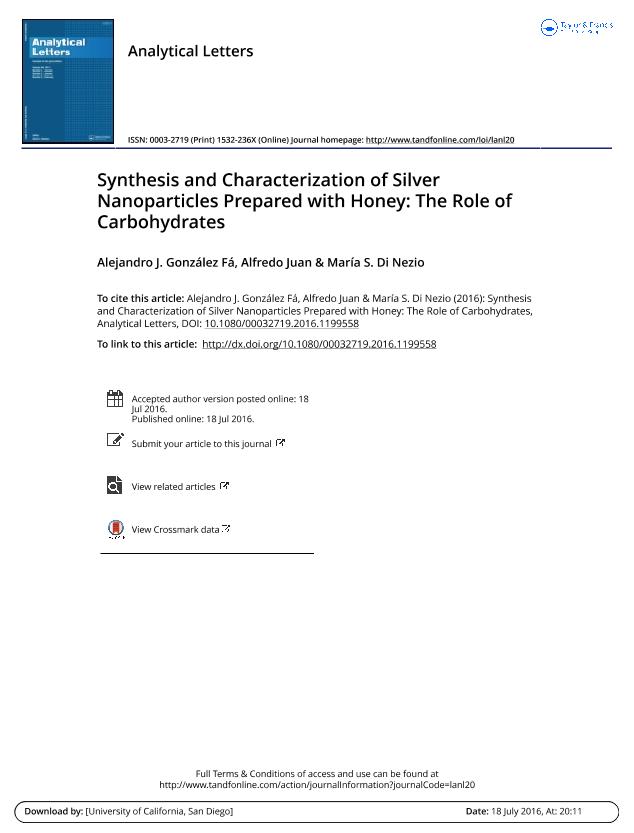Mostrar el registro sencillo del ítem
dc.contributor.author
González Fá, Alejandro Javier

dc.contributor.author
Juan, Alfredo

dc.contributor.author
Di Nezio, Maria Susana

dc.date.available
2018-11-06T16:36:56Z
dc.date.issued
2017-03
dc.identifier.citation
González Fá, Alejandro Javier; Juan, Alfredo; Di Nezio, Maria Susana; Synthesis and Characterization of Silver Nanoparticles Prepared with Honey: The Role of Carbohydrates; Taylor; Analytical Letters; 50; 5; 3-2017; 877-888
dc.identifier.issn
0003-2719
dc.identifier.uri
http://hdl.handle.net/11336/63764
dc.description.abstract
Silver nanoparticles were synthesized using honey at pH 5.0 and 10.0 using a rapid, low cost, and simple technique. The influence of the honey carbohydrates (glucose and fructose) in the synthesis was characterized. Moreover, the kinetic variables in the synthesis at room temperature and at pH 5.0 and 10.0 were analyzed by measuring surface plasmon resonance at 411 nm by absorption spectroscopy. Transmission electron microscopy, thermal gravimetric analysis, and differential thermal analysis were used to characterize the metal nanoparticles and the capping agents. The synthesized nanoparticles were obtained for the first time at pH 5.0. This fact allows evaluating the kinetics and reaction mechanism. The obtained nanoparticles were spherical, monodispersed, and smaller than 20 nm. The results show that glucose serves as a reducing and capping agent while fructose has a limited reducing effect.
dc.format
application/pdf
dc.language.iso
eng
dc.publisher
Taylor

dc.rights
info:eu-repo/semantics/openAccess
dc.rights.uri
https://creativecommons.org/licenses/by-nc-sa/2.5/ar/
dc.subject
Differential Thermal Analysis
dc.subject
Silver Nanoparticles
dc.subject
Surface Plasmon Resonance
dc.subject
Thermogravimetric Analysis
dc.subject.classification
Nano-materiales

dc.subject.classification
Nanotecnología

dc.subject.classification
INGENIERÍAS Y TECNOLOGÍAS

dc.title
Synthesis and Characterization of Silver Nanoparticles Prepared with Honey: The Role of Carbohydrates
dc.type
info:eu-repo/semantics/article
dc.type
info:ar-repo/semantics/artículo
dc.type
info:eu-repo/semantics/publishedVersion
dc.date.updated
2018-10-22T18:02:51Z
dc.identifier.eissn
1532-236X
dc.journal.volume
50
dc.journal.number
5
dc.journal.pagination
877-888
dc.journal.pais
Estados Unidos

dc.conicet.avisoEditorial
This is an Accepted Manuscript of an article published by Taylor & Francis in Analytical Letters on 18 Jul 2016, available online: https://doi.org/10.1080/00032719.2016.1199558
dc.description.fil
Fil: González Fá, Alejandro Javier. Consejo Nacional de Investigaciones Científicas y Técnicas. Centro Científico Tecnológico Conicet - Bahía Blanca. Instituto de Química del Sur. Universidad Nacional del Sur. Departamento de Química. Instituto de Química del Sur; Argentina
dc.description.fil
Fil: Juan, Alfredo. Consejo Nacional de Investigaciones Científicas y Técnicas. Centro Científico Tecnológico Conicet - Bahía Blanca. Instituto de Física del Sur. Universidad Nacional del Sur. Departamento de Física. Instituto de Física del Sur; Argentina
dc.description.fil
Fil: Di Nezio, Maria Susana. Consejo Nacional de Investigaciones Científicas y Técnicas. Centro Científico Tecnológico Conicet - Bahía Blanca. Instituto de Química del Sur. Universidad Nacional del Sur. Departamento de Química. Instituto de Química del Sur; Argentina
dc.journal.title
Analytical Letters

dc.relation.alternativeid
info:eu-repo/semantics/altIdentifier/url/https://www.tandfonline.com/doi/abs/10.1080/00032719.2016.1199558
dc.relation.alternativeid
info:eu-repo/semantics/altIdentifier/doi/http://dx.doi.org/10.1080/00032719.2016.1199558
Archivos asociados
